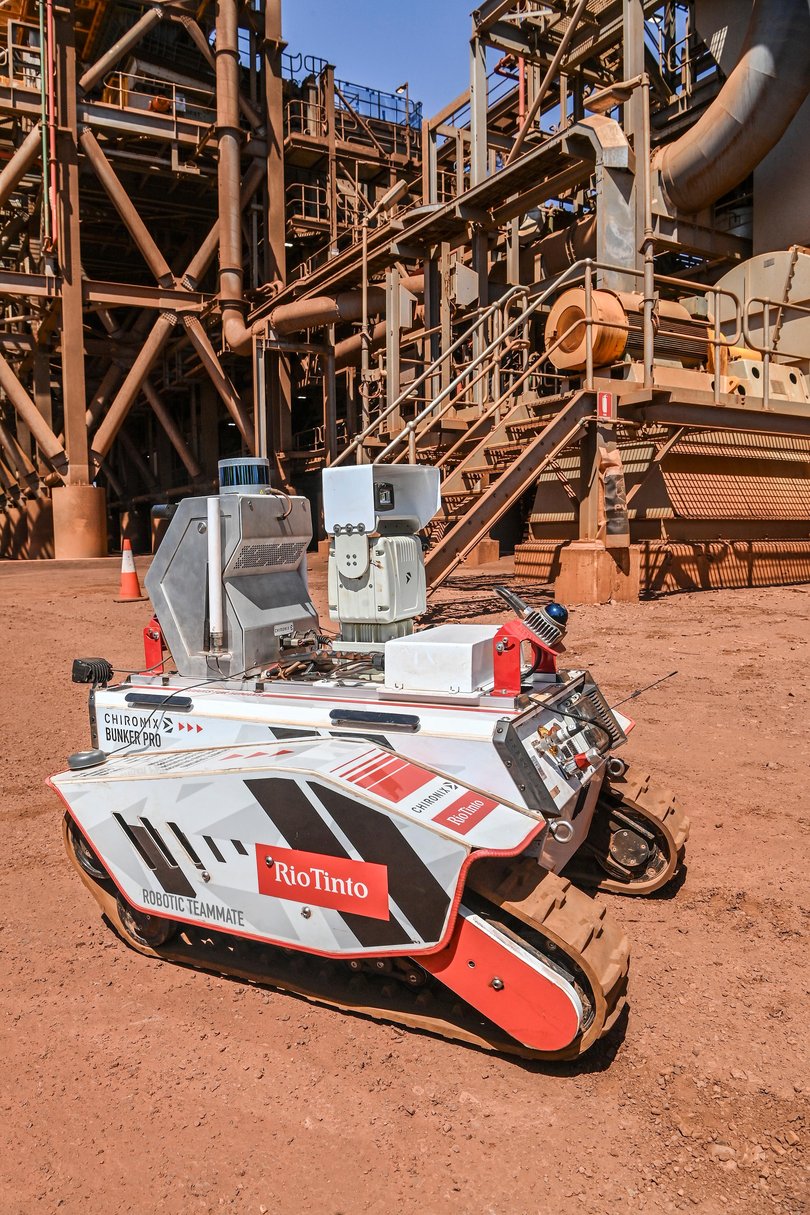Rio Tinto's Defence Of Its Pilbara Operations Amidst Environmental Criticism

Table of Contents
Rio Tinto's Environmental Impact in the Pilbara
Rio Tinto's Pilbara operations, while economically significant, undeniably present environmental challenges. The company's defense rests on a multi-pronged approach to mitigating its impact across various environmental spheres.
Greenhouse Gas Emissions and Climate Change
Rio Tinto's Pilbara operations contribute significantly to its overall greenhouse gas emissions. The company acknowledges this and has set ambitious targets for emissions reduction, focusing on decarbonization strategies. These include investments in renewable energy sources, such as solar and wind power, to replace fossil fuel-based energy in their operations. They're also exploring carbon capture and storage (CCS) technologies to further reduce their carbon footprint. However, critics argue that these targets are not ambitious enough and that the company's reliance on fossil fuels remains substantial. The effectiveness of their strategies is subject to ongoing debate and scrutiny.
- Scope 1, 2, and 3 emissions data: Publicly available data reveals a significant carbon footprint, with ongoing efforts to improve transparency.
- Renewable energy investments: Rio Tinto has invested millions in renewable energy projects within the Pilbara, aiming for a substantial shift towards cleaner energy.
- Carbon capture and storage (CCS) initiatives: Pilot projects and research are underway, but the widespread implementation of CCS remains a long-term goal.
- Transportation emissions reduction plans: Optimizing transportation routes and exploring alternative fuel sources for heavy vehicles are key components of their strategy.
Water Usage and Management in the Arid Pilbara
The Pilbara is an arid region with limited water resources. Rio Tinto's water usage for mining operations is a major point of contention. The company defends its practices by highlighting its water recycling and conservation efforts. They employ advanced water treatment technologies to recycle water used in the mining process, minimizing reliance on fresh water sources. However, concerns persist regarding the potential depletion of groundwater and the impact on local ecosystems, particularly on fragile riparian habitats.
- Water recycling rates: Rio Tinto reports high water recycling rates, but independent verification is crucial.
- Groundwater management plans: These plans aim to minimize impact on groundwater resources, but their effectiveness is debated.
- Impact on local water resources: Studies assessing the long-term effects on local water systems are ongoing and vital.
- Water-efficient technologies implemented: The company invests in technology to improve water use efficiency, but further innovation is needed.
Biodiversity Loss and Habitat Destruction
Large-scale mining inevitably impacts biodiversity. Rio Tinto acknowledges the loss of habitat and the impact on local flora and fauna in the Pilbara. The company maintains that it undertakes extensive biodiversity offsetting and conservation programs to mitigate these impacts. These programs aim to rehabilitate disturbed areas and protect threatened species. However, critics argue that these offsetting programs are not always effective in fully compensating for habitat loss and that the long-term impacts on biodiversity remain unclear.
- Species impacted by mining: Several plant and animal species have been identified as being affected by mining activities.
- Habitat rehabilitation projects: Rio Tinto undertakes large-scale rehabilitation projects, aiming to restore native vegetation and ecosystems.
- Biodiversity monitoring programs: Ongoing monitoring is essential to assess the effectiveness of conservation measures.
- Indigenous land management collaboration: Rio Tinto collaborates with Indigenous groups to integrate traditional ecological knowledge into its conservation strategies.
Rio Tinto's Sustainability Initiatives and Corporate Social Responsibility
Rio Tinto's defense extends beyond environmental mitigation to encompass broader sustainability initiatives and corporate social responsibility (CSR) efforts.
Community Engagement and Stakeholder Dialogue
Engaging with local communities and Indigenous groups is central to Rio Tinto’s approach. The company highlights its investments in community benefit agreements, job creation, training programs, and cultural heritage protection initiatives. However, criticisms arise regarding transparency and the effectiveness of consultation processes. Ensuring meaningful participation and addressing community concerns remains a significant challenge.
- Community benefit agreements: These agreements aim to share the economic benefits of mining with local communities.
- Job creation and training programs: Rio Tinto invests in training and employment opportunities for local residents.
- Cultural heritage protection initiatives: Efforts are made to protect culturally significant sites and artifacts.
- Feedback mechanisms for community concerns: Formal channels for community input are essential for effective engagement.
ESG Reporting and Transparency
Rio Tinto's commitment to Environmental, Social, and Governance (ESG) reporting is a key element of its defence. The company publishes extensive sustainability reports detailing its environmental performance, social impact, and governance practices. However, the accuracy and comprehensiveness of these reports are subject to scrutiny from ESG rating agencies and independent analysts. Transparency regarding environmental incidents and the effectiveness of their mitigation measures are continually being assessed.
- ESG rating agencies’ assessments: Independent assessments provide external validation of Rio Tinto's ESG performance.
- Public reporting of environmental data: Data transparency is crucial for stakeholders to assess the impact of mining operations.
- Independent audits of sustainability initiatives: Regular audits enhance accountability and build stakeholder trust.
- Transparency regarding environmental incidents: Open communication about incidents fosters trust and demonstrates a commitment to accountability.
Counterarguments and Criticisms of Rio Tinto's Defence
Despite Rio Tinto's efforts, criticisms persist. Independent environmental impact assessments often reveal discrepancies between Rio Tinto's claims and the actual environmental impact. Reports from NGOs and environmental groups highlight concerns about the long-term effects of mining on the Pilbara's fragile ecosystem. Government regulatory oversight and findings further contribute to the ongoing debate, reflecting the complexity of balancing economic development with environmental protection. Public opinion and media coverage also play a significant role in shaping the narrative surrounding Rio Tinto's Pilbara operations.
- Independent environmental impact assessments: These assessments provide valuable independent perspectives on the environmental impact.
- Reports from NGOs and environmental groups: NGOs often play a crucial role in monitoring and reporting on environmental issues.
- Government regulatory oversight and findings: Government agencies play a key role in enforcing environmental regulations.
- Media coverage and public opinion: Media coverage and public perception significantly influence the debate.
Conclusion
Rio Tinto's defence of its Pilbara operations highlights the complex interplay between economic development and environmental stewardship. While the company has implemented numerous sustainability initiatives, ongoing criticism underscores the need for greater transparency, stronger stakeholder engagement, and demonstrably effective mitigation strategies. A balanced approach, prioritizing both economic growth and environmental protection, is crucial for the long-term sustainability of Rio Tinto's Pilbara operations and the preservation of this unique and valuable ecosystem. To gain a comprehensive understanding, further research into Rio Tinto's sustainability reports and independent assessments is strongly recommended. Continue to stay informed about the ongoing dialogue surrounding Rio Tinto's Pilbara operations and the broader conversation on responsible mining practices.

Featured Posts
-
 Jonathan Groffs Just In Time A Night Of Broadway Stars And Friendship
May 24, 2025
Jonathan Groffs Just In Time A Night Of Broadway Stars And Friendship
May 24, 2025 -
 Leistungstraeger In Essen Der Aufstieg Von Golz Und Brumme
May 24, 2025
Leistungstraeger In Essen Der Aufstieg Von Golz Und Brumme
May 24, 2025 -
 Daks Alalmany Ytkhta Dhrwt Mars Awl Mwshr Awrwby Yhqq Hdha Alinjaz
May 24, 2025
Daks Alalmany Ytkhta Dhrwt Mars Awl Mwshr Awrwby Yhqq Hdha Alinjaz
May 24, 2025 -
 Semana Del 4 Al 10 De Marzo De 2025 Horoscopo Completo Para Cada Signo
May 24, 2025
Semana Del 4 Al 10 De Marzo De 2025 Horoscopo Completo Para Cada Signo
May 24, 2025 -
 Porsche Atidare Nauja Elektromobiliu Ikrovimo Stoti Europoje
May 24, 2025
Porsche Atidare Nauja Elektromobiliu Ikrovimo Stoti Europoje
May 24, 2025
